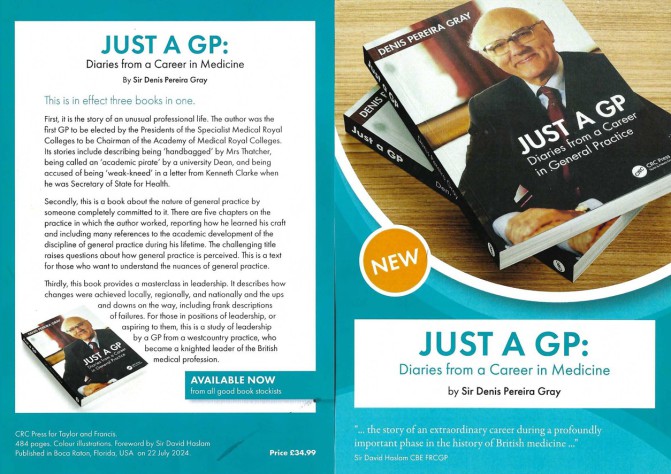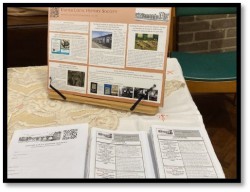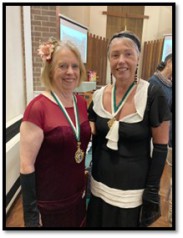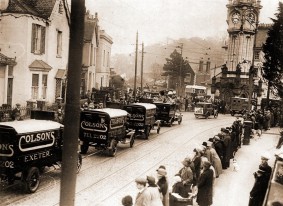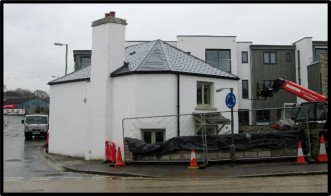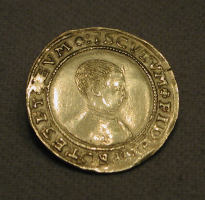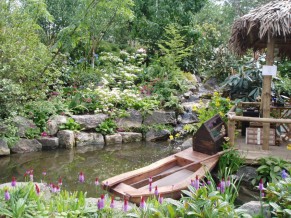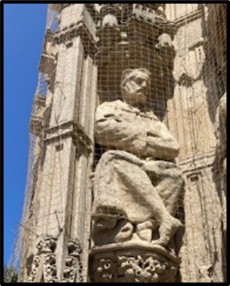
2025
An excerpt from Sir Denis Pereira Gray's memoir
"Just a GP — Diaries from a Career in Medicine"
with Sir Denis Pereira Gray on Thursday, 13 November 2025
at 7pm at Leonardo Hotel Exeter [Jurys Inn Exeter Hotel]
Denis Pereira Gray was born in Exeter, the son, nephew, grandson, and father of GPs. He worked as a GP himself here for 38 years. He became the first Professor of General Practice at the University of Exeter and was then elected President of the Royal College of General Practitioners, and Chairman of the Academy of all the Medical Royal Colleges. He describes how medical research has made general practice an independent discipline and what this means for patients, especially in seeking to preserve continuity of care.
This illustrated talk, by a member of the Exeter Local History Society, offered a fascinating account of an unusual professional life, including his encounters with Mrs. Thatcher, a university Dean, and references to Kenneth Clarke when he was Secretary of State for Health.
Exeter in the 1920s — Fayre and Show.
With stalls by local history groups and the performance of “Best of Times, Worst of Times”
hosted by Julia Neville on Saturday, 11 October 2025
ELHS were pleased to be invited to this event in the Mint Methodist Church. Many local history and research groups were represented, including the Cathedral Archives, the Church Army, Devon and Exeter Medical Heritage Trust, St. Nicholas Priory, Heavitree Local History Society, St. Thomas’ Local History Group, Topsham Museum, Westcountry Historic Omnibus and Transport Trust, and, most importantly, the West Quarter Research Team.
We all enjoyed the dramatic presentation and performance of “Best of Times, Worst of Times” – consisting of oral history and music from the 1920s. We heard about the lives of residents of the West Quarter, which was very moving. We learnt of the poverty and precarious existences endured by the residents of that deprived area of our city in the 1920s. However, there were also happy times, which were highlighted by the actors. In addition, there was a musical interlude performed by “The Song Fishers”.
The Lord Mayor of Exeter, Anne Jobson, opened the proceedings with a short speech. She and her consort had both entered into the spirit of the occasion by dressing the part and spent some time going round the displays and speaking to the members of the different groups. The occasion was a happy occasion, and everyone there seemed to be having a good time.
With thanks to Julia Neville for an entertaining and enjoyable afternoon.
Judith Hosking
Exeter in the 1920s — Sunshine and Shadows
with Dr Julia Neville on Thursday, 9 October 2025
at 7pm at The Mint Methodist Church Centre
Exeter in the 1920s was a place of huge contrasts, with both 'Sunshine' and 'Shadows'. Shadows of unemployment, poverty and wartime trauma clouded the decade, but many people were able to enjoy new houses and new opportunities to go out and enjoy themselves. The Festival of Devon in the 1920s was showcasing these different aspects in a series of events in Exeter, including this evening's historical entertainment at The Mint Methodist Centre.
The main event of the evening was a dramatic presentation, The Best of Times, the Worst of Times, based on the lives of real Exeter people from the West Quarter. The cast of characters who recounted their personal stories included, amongst others, a landlady, a badger expert, an ice-cream manufacturer and a victim of childhood polio. To get us in a 1920s mood, the evening began with a swing. In a film by John Tomkinson for the Festival of Devon in the 1920s, the South West Lindy Hoppers are shown dancing the (rather shocking) 1920s' dance imported from the United States, the Charleston, in Exeter's Historic Guildhall.
The Toll Houses of Devon
with Tim Jenkinson on Thursday, 11 September 2025
at 7pm at Leonardo Hotel Exeter [Jurys Inn Exeter Hotel]
Turnpike Trusts in Devon were set up through various Acts of Parliament from 1753-1831, usually resulting from vigorous petitioning by local worthies about the state of the roads in the County. Their remit was to repair existing roads and, where necessary, widen and build new sections. The Exeter Turnpike Trust was the first to be formed and at its peak had responsibility for around 150 miles within the County.
Tolls were to be charged to horse-drawn travellers to fund the road repairs and to facilitate a 24-hour presence of their collectors, the Turnpike Trusts built small associated dwellings at their gates - the toll-houses. They generally comprised very minimal accommodation of two rooms with a scullery and privy attached, although larger types did become more common in later years. Usually one or two storeys high, the houses came in many shapes and sizes. They were both functional and, to some extent, expressions of architectural style, often employing an octagonal ground plan to advertise their special purpose. Today, in the first half of the 21st Century, many of these roadside buildings survive as private dwellings in Devon.
Tim’s illustrated talk included examples of survivors within the County and will place particular emphasis on those houses that operated for the Exeter Turnpike Trust, with some tales of the toll-collectors from the mid to late 19th Century. There were references to turnpike-related items such as milestones, including a remarkable set of markers running from the city out to Chudleigh that received Grade II listed status as recently as 2017.
Our speaker, Tim Jenkinson, has lived in South Devon since 1988. He has had successful careers at the University of Plymouth, where he taught nursing, and as a local historian. As a historian, he has written and published a number of articles and books about the history of Devon, including books about toll houses.
Semper Fidelis:
Rebellion, history and identity in Tudor & Stuart Exeter
on Wednesday, 6 August 2025
from 2 pm until 5 pm at Exeter Guildhall
The event featured two talks:
Professor Mark Stoyle, "Semper Fidelis: The Civic Community of Exeter and the Memory of the Western Rising of 1549"
Exeter people have long been proud of their city's ancient motto Semper Fidelis (i.e., "Ever Faithful"). But how ancient is that motto? Why was it chosen in the first place? And how does it relate to the so-called "Jesus Day" festivities which were formerly celebrated in the city every 6 August? Mark Stoyle's lecture explored these questions, and, in the process, revealed that the motto which lies at the heart of Exeter's modern-day "civic brand" has its roots in the bitter religious rivalries of the mid-sixteenth century.
Dr Todd Gray, "Exeter's myths and manuscripts of the 1500s"
Exeter has a particularly rich archive for the Elizabethan period and yet the city's history has had some extraordinary fabrications. In this lecture, Dr Gray outlined some of those myths and reveal the staggering documents that we take for granted.
Exotic Plants and Intrepid Collectors:
Veitch, the Devon Years
with Caradoc Doy on Thursday, 10 July 2025
at 7pm at Leonardo Hotel Exeter [Jurys Inn Exeter Hotel]
Caradoc Doy travels widely to give interesting and entertaining gardening talks. He has also become a specialist studying the work of the Veitch nurseries of Exeter and Chelsea and their many pioneering plant collectors, as well as other horticultural stories.
This talk is a brief history of a remarkable nursery which sent twenty-three plant collectors to numerous countries — mainly during the Victorian period. William and Thomas Lobb, Richard Pearce, John Gould Veitch and Peter Veitch, Frederick Burbidge, Charles Maries, Ernest Wilson, and others all worked for the Veitch family nurseries of Exeter and Chelsea.
The presentation highlighted some of the well-known and interesting varieties introduced by these pioneering plant hunters who discovered many hundreds of new species. So successful were they that there is scarcely a garden in the British Isles that does not contain a plant derived from their introductions.
Our speaker, Caradoc Doy, is an experienced horticulturist and an authority on the history of plants introduced during the Victorian period.
“Royal Visitors to Exeter”
A Guided Walk
Led by Redcoat Guide Mike Richards
on Thursday, 12 June 2025
starting at 2pm from the West Front of the Cathedral
This walking tour, which lasted about 90 minutes, started and finished at the West Front of Exeter Cathedral.
Mike detailed Royal visitors to our city from the time of Athelstan in the 10th century, right up to the present day.
They were not all gracious events.
We heard of a Viking King of England, William of Normandy, an Iberian princess (whose name would go down in history), William of Orange, a deceased Duke, a King who would give (or sell) his sword to the city, a Shakespearean connection and many other intriguing true events.
The Curator and the Curious
Miss Tothill, the first Curator of St. Nicholas Priory
with Ben Clapp on Thursday, 8 May 2025
at 7pm at Leonardo Hotel Exeter [Jurys Inn Exeter Hotel]
When St Nicholas Priory opened as a Museum in 1916, Miss Tothill was appointed as Curator of the building. Expected to be little more than a custodian, she transformed the Priory into a place that entertained and astounded the curious who visited. This included Authors, Musicians and even Royalty. More than that it even became the home for several Ravens!
This tale has come to light due to the recent discovery of her scrapbook of her time there. This remarkable document, long known of but believed lost, has illuminated the Priory during her time there, and shows her amazing foresight for posterity.
Ben Clapp told us the story of a remarkable woman who brought St Nicholas Priory to life for its many visitors for over two decades, and in turn has become an integral part of its history.
Ben Clapp works at the Royal Albert Memorial Museum and has been involved with St Nicholas Priory for over seventeen years and has studied it almost as long. Focussing on the last few hundred years of the building's history, he has uncovered many unique and wonderful stories and facts about the place and is always willing to tell people about them!
Exeter City Walls
with Dr Stuart Blaylock on Thursday, 10 April 2025
at 7pm at Leonardo Hotel Exeter [Jurys Inn Exeter Hotel]
From the time of its first construction in the late 2nd century AD the city wall of Exeter has encircled the town and defined its historic core.
The talk offered a summary of research on the wall over the years:
- how the understanding of the defences, including ditches and ramparts, developed;
- how the identification of surviving original Roman work has ebbed and flowed; and
- the many different phases of repair and rebuilding that have made the wall the patchwork of Roman, Medieval and later masonry that we see today.
Dr Blaylock also talked about current issues of repair and maintenance, since the wall is probably under more of a threat today than at any time in the last century.
Our speaker, Dr Stuart Blaylock, is an independent scholar and archaeologist who has lived and worked in and around Exeter since 1978. In 2022, he gave an insightful talk about the Rougemont Castle to the Society.
What can a graveyard tell us about Georgian Exeter?
with Dr Ian Varndell on Thursday, 13 March 2025
at 7pm at Leonardo Hotel Exeter [Jurys Inn Exeter Hotel]
A patch of land smaller than two tennis courts, located just outside Exeter’s city walls, became a burial ground for protestant dissenters for just over 100 years. Around 2,000 people were buried there before it closed in 1854.
Dr Ian Varndell talked to us about the origins of the site and the non-conformist congregations who paid for it; he described how and, more importantly, why it had been conserved.
A small group has been researching the lives of Exeter’s dissenting families, and Ian finished with stories of three Exonians who were buried in “Saints Rest” – giving us a glimpse into their lives more than two centuries ago.
The Dissenters Graveyard, Magdalen Street, is open for visits on Wednesdays and Saturdays 10.00-4.00.
Our speaker, Dr Ian Varndell, is a retired bioscientist and company director deeply interested in historic landscapes, including burial grounds.
A Family Tale from Tudor Exeter to the Eastern Shore of Virginia:
The Chappell and Bagwell Families
with Maggie Rice on Thursday, 13 February 2025
at 7pm at the Leonardo Hotel Exeter
William and Thomas Chappell and their cousin John were successful merchants and important civic personalities. Each would serve as Mayor of Exeter during the reign of Queen Elizabeth I.
This presentation focused on the family of Thomas and Thomazine, their personal lives in Tudor Exeter, and the story of their daughter, Johane, who married Thomas’s apprentice, David Bagwell. Their second son, Henry Bagwell, left England in 1609 with the supply fleet sent to Jamestown - England’s first permanent colony in the New World. He survived a shipwreck, having been marooned in Bermuda. He eventually reached Virginia in 1610.
Henry survived the early days of the colony and became a key member of the emerging society on the Eastern Shore of Virginia. In 1639 he was granted a patent of 400 acres, married, and had three children, as well as being a step-father of three children.
Our speaker, Margaret A. “Maggie” Rice, has enjoyed a long and successful career as a teacher and school administrator. She is the author of “Merchants and Mayors: the Chappell Family in Tudor Exeter” and “The Henry Bagwell Story: English Adventurer, Virginia Planter (1589-1663)”.
Exeter History Book Festival
A celebration of the recently published books on Exeter's history
on Saturday, 1 February 2025
at The Mint Methodist Church Centre
The Exeter History Book Festival celebrated the latest research on the history of Exeter. This was a one-day event and featured four of the foremost scholars of Devon’s history:
| 9.30 | Registration & coffee |
| 10.25 | Welcome |
| 10.30 | Prof. Mark Stoyle, "Witchcraft in Exeter, 1558-1660" |
| 11.30 | Dr Todd Gray, "Exeter's Waterwog & the Golliwogg" |
| 12.30 | Lunch |
| 13.30 | John Allan, "The Cloisters of Exeter Cathedral" |
| 14.30 | Dr Richard Batten, "A Loyal and Faithful City? Exeter during the Great War" |
“Through the Traveller’s Eye”
with Dr Alan Rosevear on Thursday, 9 January 2025
at 7pm at Leonardo Hotel Exeter [Jurys Inn Exeter Hotel]
This was an exploration of inland travel in the late 18th and early 19th centuries, based on travel diaries and contemporary illustrations. Through the personal diaries of men and women who journeyed across Southwest England, the talk addressed what modes of transport they chose, why they travelled and their experiences along the way. Their tales were illustrated with pictures made at the time and maps that plotted their itineraries.
Our speaker, Dr Alan Rosevear, is a retired research scientist with a life-long fascination with the history of roads and transportation.
